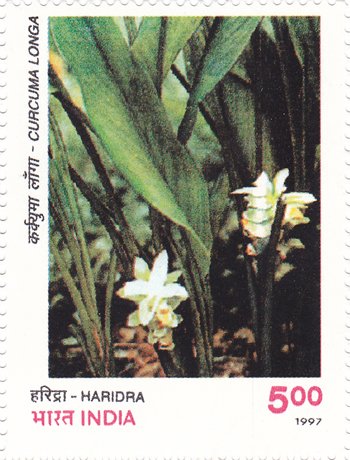Haridra (Curcuma longa)

Technical Data
| Stamp Set | Indian Medicinal Plants |
|---|---|
| Date of Issue | October 28, 1997 |
| Denomination | Rs. 5 |
| Perforation | comb 14 |
| Printer | Security Printing Press, Nashik |
| Watermark | No Watermark |
| Colors | Multicolor |
| Catalog Codes |
Michel IN 1584 Stamp Number IN 1641 Yvert et Tellier IN 1356 Stanley Gibbons IN 1748 |
| Themes | Plants (Flora) |
Table of Contents
Commemorative Stamp Set: Indian Systems of Medicine
Design Elements:
- The stamp set prominently features Haridra (Curcuma longa), commonly known as turmeric, a cornerstone of Ayurvedic medicine.
- Shri Dhanwantri, the revered originator of Ayurveda, is depicted as a central figure, symbolizing the deep roots of traditional Indian medicine.
- The background showcases the rich biodiversity of India, with the lush landscapes of the Eastern Himalayas and Western Ghats, regions renowned for their medicinal plants.
Cultural and Historical Significance:
- Haridra (Turmeric) has been used for thousands of years in India, both as a culinary spice and a powerful medicinal herb. It is celebrated for its anti-inflammatory, antioxidant, and antimicrobial properties.
- The Indian systems of medicine, including Ayurveda, Siddha, and Unani, emphasize the importance of natural remedies in maintaining balance within the body, a concept rooted in India’s ancient cultural traditions.
- The use of Haridra in traditional medicine highlights India’s holistic approach to health, which integrates the body, mind, and spirit.
Usage:
- The commemorative stamp set is designed to celebrate and promote the Indian systems of medicine, particularly the role of Haridra in Ayurvedic treatments.
- It serves as a tool to raise awareness about the significance of natural remedies and the rich biodiversity that supports them.
Importance of the Commemorative Stamp Set:
- This stamp set honors the legacy of Shri Dhanwantri and the enduring relevance of Ayurvedic medicine in modern healthcare.
- By featuring Haridra, the stamp highlights India’s contribution to global health through the use of natural resources and traditional knowledge.
Example of the Stamp Design:
- The stamp design could showcase Haridra (Turmeric) in its natural form, with its vibrant yellow rhizomes and green leaves, alongside an image of Shri Dhanwantri.
- The background could depict a traditional Ayurvedic setting, with a mortar and pestle, emphasizing the preparation of natural medicines.
Significance:
- The stamp set serves as a tribute to the rich heritage of Indian medicine and its continued importance in the global health landscape.
- It underscores the value of preserving traditional knowledge and the natural environment, both of which are integral to the practice of Ayurveda and other Indian medical systems.
